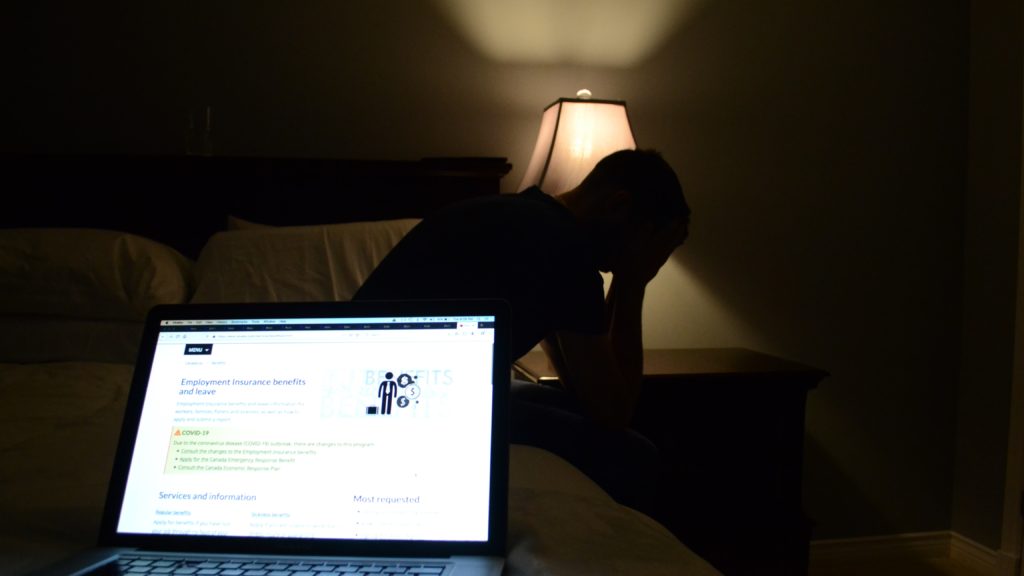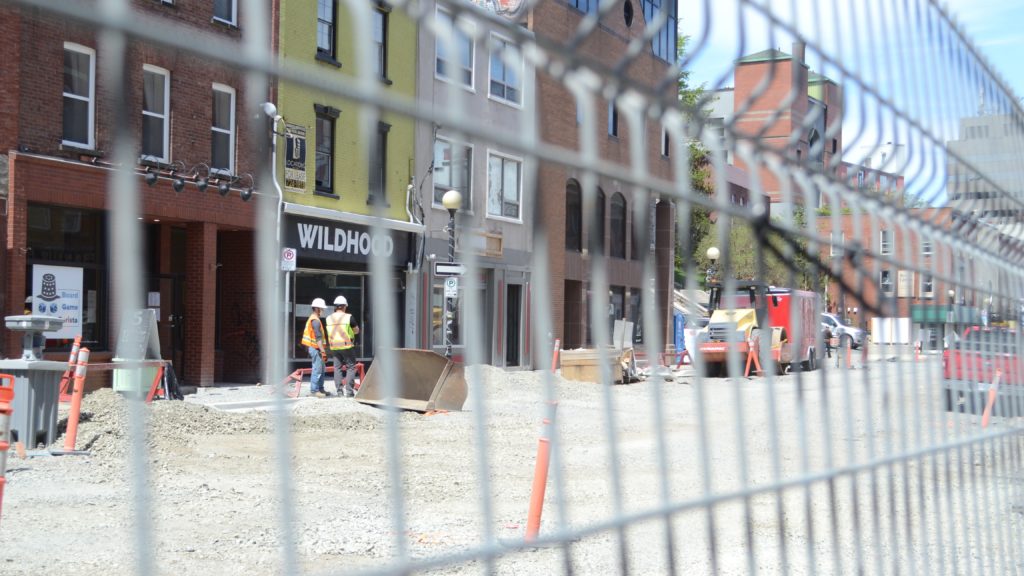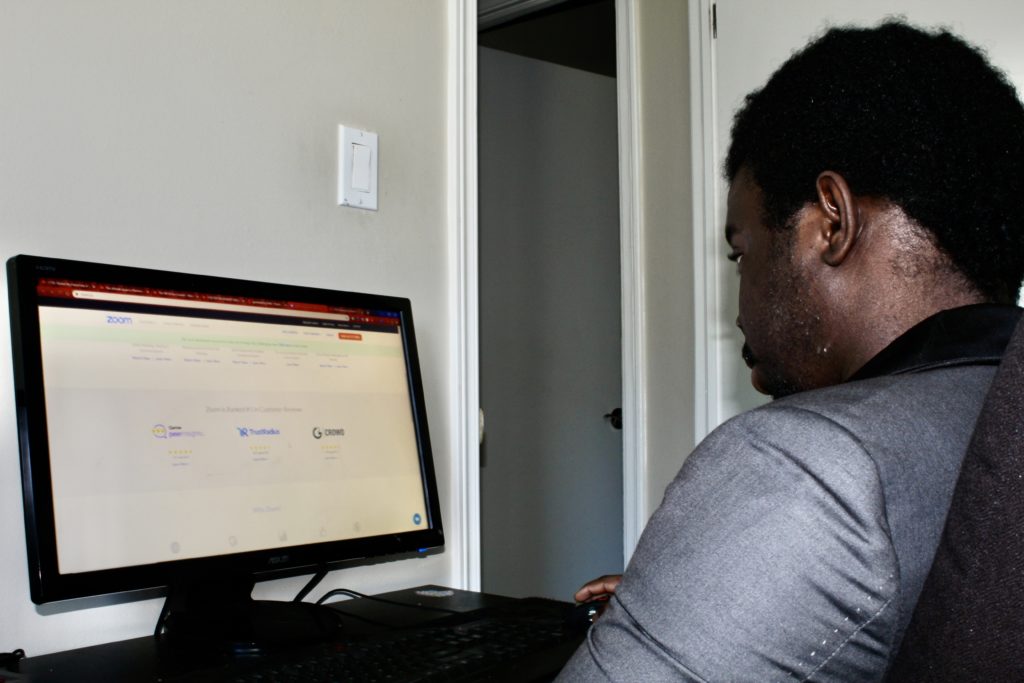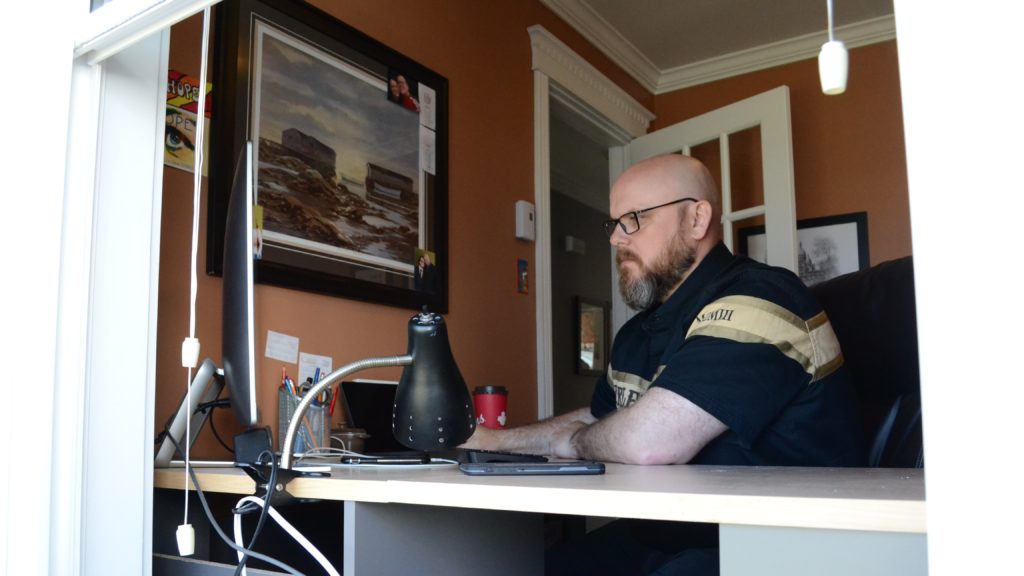
COVID-19 brings unemployment for some and new work models for others in the province.
Henrike Wilhelm
Kicker
Justin Murphy should be on the mainland now, at work. Instead, he’s in the basement of his girlfriend’s grandfather in St. John’s, doing renovations.
Murphy is a non-destructive testing technician in the oil and gas sector. Before COVID-19, he used to fly to his jobs, mostly in Alberta, and come back to Newfoundland for his time off. He was sent home on March 15 and hasn’t worked since then.
“I’m pretty stressed out at this point because there’s nothing that I have lined up. I’ve been trying, but it’s just not going good,” said Murphy.
One week after COVID-19 was declared a pandemic by the WHO, Newfoundland and Labrador’s government announced a public health emergency. Immediately, all businesses that don’t provide essential services closed. That was on March 18.
On May 11, roughly eight weeks later, the province moved to alert level 4. While some businesses were allowed to re-open, the doors of retail stores, gyms, restaurants and cafés remained closed and employees were encouraged to work from home if possible.

A century ago, when the Spanish flu hit Newfoundland and Labrador in 1918, people didn’t have the option to stay home. Terry Bishop-Stirling, professor for history at MUN, studied how the last big pandemic affected people’s lives on the island and in Labrador.
Bishop-Stirling said the kind of work available in 1918 – mostly fishing, mining and logging – didn’t allow for home offices.
“It was largely resource-based,” Bishop-Stirling said, “and we didn’t have this sort of white-collar kind of work force that we have here now.” She names the fishery, mining and forestry as main sources of income.
No accurate numbers are known, but it is believed that more than 1,000 people died in the province during the Spanish flu epidemic. Most of them were young people in their prime working years. Whether or not home offices would have made a difference in the number of fatalities back then can only be speculated on but has to be considered.
“When I got approved for a house, it was on a certain salary. So, now that I’m not making that salary, it’s getting tough.”
– Justin Murphy
More than 100 years later, much has changed about the workplace. Modern technology and a higher number of white-collar jobs offer ways to work without physical contact with other people.
Yet, increased awareness of infectious diseases and workplace safety has also led to more businesses being ordered to close during this pandemic. These closures resulted in a high number of workers being either laid off temporarily or let go for good.
Mary Shortall, president of the Newfoundland and Labrador Federation of Labour, says that while it is important for government to help local businesses who had to close during the pandemic, the crisis has also shown that support for workers needs to be improved.
“We’ve learned throughout this pandemic how important income support programs are, how important it is to put money in people’s pockets, how shameful it is that we have a whole group of workers out there who are keeping us safe and well who are using food banks because their wages and their hours of work and working conditions are so awful,” Shortall said.
Shortall says COVID-19 has exposed flaws in the system and demands change to benefit workers. “We’re asking government to do those things, to make those changes, to take the lead, just like the federal government is doing right now and to make sure that workers don’t get left behind.”
She says only investments will help individuals now.
“Canadians understand that you need to put money in people’s pockets, you need to have strong social programs, you need to have good public infrastructure programs to encourage people to live here and work here and spend their money here and that’s what grows the economy and that’s what will create jobs in the private sector as well.”
One of the people who might not be able to live in the province much longer is Justin Murphy.
The situation is taking a financial toll on him, especially since he bought a house last year. “When I got approved for a house, it was on a certain salary. So, now that I’m not making that salary it’s getting tough,” Murphy said.
Murphy now has to evaluate how long he can wait until he needs to make a decision about his future. He says he might have to rent out the top half of his house and move in with his girlfriend. Or he might move to another province to be closer to work and thereby increase his chances of being hired.
“If I move, at least you got a better chance because they do gauge it. The closer that you are to somewhere that you are going to work they’re probably going to choose you over someone who lives…like super far away from the country. But that’s worst-case scenario.”

Murphy receives EI but says it doesn’t make up for having a job. “The max EI you get, it’s like, it doesn’t cover my bills for my house and stuff. And not only that, if you make a certain amount you need to pay back like 30 per cent of that. So, come tax time you get dinged and then you pay out of pocket.”
Murphy is not alone.
Numbers by the Newfoundland and Labrador Statistics Agency show the sector that encompasses forestry, fishing, mining, oil and gas took a deep plunge, with employment numbers down by 26.1 per cent from March to April. No other industry saw a bigger drop.
Yet, with the easing of restrictions across the country, the sector seems to be recovering. In May 2020, the number of people employed in forestry, fishing, mining, oil and gas went up to 14,200 again, from 8,800 in April.

This phenomenon can be seen across the entire economy. In April 2020, the unemployment rate in the province was at 18.2 per cent. That is an increase of 36.8 per cent from the previous month (13.3 per cent) and a 41.1 per cent increase from April 2019 (12.9 per cent), almost double.
In May 2020, the provincial unemployment rate went down again and is currently at 17.1 per cent.
Alongside personal losses such as those of Murphy, the small business sector will most likely face financial damage.
Rhonda Tulk-Lane, acting CEO of the St. John’s Board of Trade, says while some businesses have found ways to prosper in the crisis, others will have to shut down.
Tulk-Lane mentions the local sports store That Pro Look, which has started selling face masks with NHL team logos, and Coffee Matters, which had to give up its café in Mount Pearl, as examples of two sides of the same coin.
“So, we’re saying, please open the economy as fast as you can as safely as you can.”
– Rhonda Tulk-Lane, acting CEO of the St. John’s Board of Trade
From May 1 to June 10, the province registered just four new cases of COVID-19. Yet, the provincial government only cautiously eased restrictions. The step to alert level 3 came on June 8. Restaurants, cafés and retail stores were allowed to open for normal business, given they adhere to safety regulations put out by the government.
According to a survey conducted by the Canadian Federation of Independent Business (CFIB) on May 28, only 20 per cent of Newfoundland and Labrador respondents said their businesses were fully open. That’s the lowest number in the country.

Tulk-Lane says she knows this apparent discrepancy between numbers of infections and the government’s pace at lifting restrictions has made some people scratch their heads. However, the St. John’s Board of Trade heeds advice from Chief Medical Officer Fitzgerald and acknowledges the board itself an expert in business, not health.
Therefore, the board has been calling for the opening of the economy as soon as it’s justifiable. “We’re walking the line, trying to take everyone’s perspective into account while getting our businesses ready,” said Tulk-Lane. “So, we’re saying, please open the economy as fast as you can as safely as you can.”
A new range of products, like personalized face masks, is one way for business owners to cater to a changed market. Another one is to adjust to the way customers are shopping by offering e-commerce and curbside pickup.
“My business is down about 65 per cent. So, that’s a huge number to overcome.”
– Ken Pittman, owner of Seto Kitchen and Bar
The curbside model has been essential for businesses that were, until recently, ordered to keep their doors closed to the public, like restaurants. For some, these new approaches had come before they ever served a single plate of food.
Brewdock Beer Bar and Eatery is the latest addition to the St. John’s downtown bar scene. With the bright orange building on Duckworth Street still under construction, owners Steve Martin and Craig Farewell have a chance to watch how fellow restaurants deal with the unforeseen.
Initially, Farewell was skeptical about the idea of curbside pickup, but he changed his mind after doing some research. “At first, it kind of seemed like it was a downer, but the more we got into it and the more we talked to our friends that all have their businesses downtown and what they’re doing and seeing their success it definitely, it was better.”
Farewell says he’s trying to see the positive. “When you think about it, when you take a place and you have a capacity, you can only ever serve the number of people that can physically fit within that capacity. But when you have curbside pickup and everybody is on board with it, your capacity is limitless.”
Yet, it is questionable whether curbside pickup alone can keep a restaurant afloat for long.
Ken Pittman, owner of Seto Kitchen and Bar on Duckworth Street and Big Boy Baos food truck, says takeout alone can’t make up for dine-in customers. “My business is down about 65 per cent. So, that’s a huge number to overcome.”
The loss of tourism caused by the pandemic further damages the industry which relies heavily on the summer months.
“We’re an industry that’s built on hospitality and especially in Newfoundland our tourism business in the summer is what helps a lot of places get through the winter. And we’re not going to get that this year,” Pittman said.
Pittman’s experience isn’t an isolated case.
According to the CFIB survey from March 28, 80 per cent of businesses in the hospitality sector nationwide are reporting a revenue drop of 30 per cent or more. Almost a quarter, 19 per cent, say they might have to shut down.
In Newfoundland and Labrador, 72 per cent of businesses overall indicate such a revenue drop.
Whether the small business sector and the provincial economy as a whole will suffer long-term damage or whether innovation will provide alternatives to balance the loss of business is a question nobody can answer yet.
Glenn Davis, vice-president of policy for the Atlantic Chamber of Commerce, identifies the hospitality industry in general as the one that has been hit the hardest. He says even now that restaurants are allowed to open for dine-in service, physical distancing measures will keep making things difficult.
“The industry associates are indicating that if you set up a restaurant with six-foot distances between tables you are going to probably run out of 50 per cent of your capacity,” said Davis.
“And 50 per cent of your capacity means you’re losing money.”

Davis says he expects curbside pickup and similar approaches to boom, at least until a vaccine for COVID-19 is found, and that this could be problematic for businesses.
“It does put a significant pressure on the workplace because if you’re not getting a lot of storefront or sidewalk traffic can you really afford to have as many employees as you used to?”
Numbers confirm that the hospitality industry and its workers have been suffering. Employment numbers sunk from 14,000 in March to 11,800 in April. That’s a decrease of 15.7 per cent. In May, the employment numbers went back up to 13,400.
The sector seems to be recovering, but is not yet back on a pre-pandemic level.

The CFIB’s poll also shows that only nine per cent of businesses in the hospitality sector are fully open, the lowest number of all sectors in the survey.
Regardless of whether a vaccine is found, Glenn Davis expects a permanent change in consumer behaviour, including a high demand for e-commerce and curbside pickup. “Whether there is or there isn’t, I think there’s going to be a fundamental change in how people operate, how they do business.”

This seems to be a prognosis everyone agrees on. Craig Farewell expects most restaurants, including his own, to keep offering curbside service beyond the time of the pandemic.
“I think even then people will keep it up,” he said, “because they put this process now into place and by the time we go back to normal they’ll have it down pat. And I mean if it’s a successful part of their business and it helps them just continue to be successful, then it’ll definitely stick around. But I think that there will always be some sort of a curbside model moving forward.”
“I think (things) will change, if not permanently because people have short memories, then I think for quite a long time.”
– Terry Bishop-Stirling, history professor at MUN
Employees have to adjust to their new work situation just as much as business owners. According to Rhonda Tulk-Lane, it takes six weeks to form a habit.
By now, Dennis Thomas has worked remotely twice as long as the habit-forming minimum.
Thomas works for the Canada-NL Offshore Petroleum Board and, like so many others, has been in his home office since the spread of the virus to the province.
He says that after a short adaptation period since starting home office on March 18, he has settled into the new normal.
“The first week or so it was… it was almost like a little mini holiday, right?” said Thomas, laughing. “You really didn’t know, but as time went by you kind of fall into that same work schedule that you’ve created for yourself and it starts to become more of a routine.”
Thomas says avoiding the daily commute is one of the benefits of home office, especially in the winter. He can imagine a mixed model where he works remotely a few days a week and goes into the office on others.

“I think I would like to work from home,” said Thomas, “but having said that I also feel that there’s times where I would probably need to be in the office for different things. Plus, the camaraderie, friendship, colleagues, which is a very important part of work as well; the interaction with your peers and your colleagues. So, there will be an aspect of that that I would like to still have even if I did work from home.”
The COVID-19 pandemic has the potential to drastically change the way people look at the workplace and the way professional and personal life are balanced. It seems that, regardless of the medical progress in the fight against the virus, the future of the workplace will look more flexible and the boundaries of when and where work is done will blur.
Terry Bishop-Stirling is certain we will see some degree of change. “I think (things) will change, if not permanently because people have short memories, then I think for quite a long time,” she said.
So far, employers and employees, like Dennis Thomas, alike seem to be noticing the possible benefits of remote work.
“Our executive has been monitoring our work,” said Thomas, “the amount of work that’s getting done to see if it’s affecting us or if productivity is down, but it seems that productivity has been up. It’s been working really well.”
For those in the province who weren’t lucky enough to keep their jobs and work from home, the latest trends in employment numbers are certainly a silver lining.
Still, Justin Murphy is trying to be realistic. “Oil is starting to go back up slowly, but I mean the big companies are probably going to try to save money where they can. So, that’s why I’m not holding my breath for any work coming up soon.”

Be the first to comment